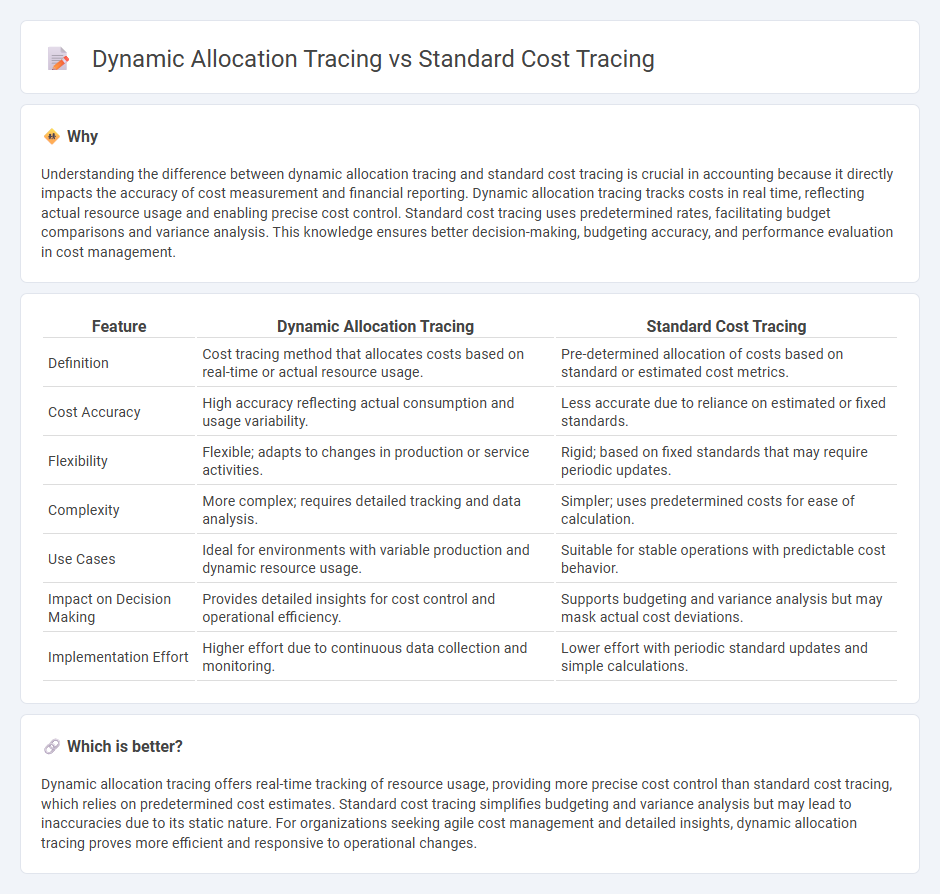
Dynamic allocation tracing enables real-time tracking of resource usage, offering precise cost allocation based on current consumption patterns. Standard cost tracing relies on predetermined rates, providing consistency but potentially less accuracy in reflecting actual operational costs. Explore detailed comparisons to understand which method best fits your accounting needs.
Why it is important
Understanding the difference between dynamic allocation tracing and standard cost tracing is crucial in accounting because it directly impacts the accuracy of cost measurement and financial reporting. Dynamic allocation tracing tracks costs in real time, reflecting actual resource usage and enabling precise cost control. Standard cost tracing uses predetermined rates, facilitating budget comparisons and variance analysis. This knowledge ensures better decision-making, budgeting accuracy, and performance evaluation in cost management.
Comparison Table
| Feature | Dynamic Allocation Tracing | Standard Cost Tracing |
|---|---|---|
| Definition | Cost tracing method that allocates costs based on real-time or actual resource usage. | Pre-determined allocation of costs based on standard or estimated cost metrics. |
| Cost Accuracy | High accuracy reflecting actual consumption and usage variability. | Less accurate due to reliance on estimated or fixed standards. |
| Flexibility | Flexible; adapts to changes in production or service activities. | Rigid; based on fixed standards that may require periodic updates. |
| Complexity | More complex; requires detailed tracking and data analysis. | Simpler; uses predetermined costs for ease of calculation. |
| Use Cases | Ideal for environments with variable production and dynamic resource usage. | Suitable for stable operations with predictable cost behavior. |
| Impact on Decision Making | Provides detailed insights for cost control and operational efficiency. | Supports budgeting and variance analysis but may mask actual cost deviations. |
| Implementation Effort | Higher effort due to continuous data collection and monitoring. | Lower effort with periodic standard updates and simple calculations. |
Which is better?
Dynamic allocation tracing offers real-time tracking of resource usage, providing more precise cost control than standard cost tracing, which relies on predetermined cost estimates. Standard cost tracing simplifies budgeting and variance analysis but may lead to inaccuracies due to its static nature. For organizations seeking agile cost management and detailed insights, dynamic allocation tracing proves more efficient and responsive to operational changes.
Connection
Dynamic allocation tracing improves the accuracy of cost tracking by monitoring resource usage in real-time, directly impacting the precision of standard cost tracing in accounting systems. Standard cost tracing relies on accurate allocation data to assign predetermined costs to products or services, facilitating variance analysis and budget control. Integrating dynamic allocation tracing with standard cost tracing enhances financial decision-making by providing more detailed and timely insights into cost behavior.
Key Terms
Cost Variance
Standard cost tracing allocates costs based on predetermined rates, which simplifies cost variance analysis by comparing actual costs against static benchmarks. Dynamic allocation tracing adjusts cost assignments in real-time to reflect operational changes, providing more accurate variance insights but requiring complex data management. Explore the nuances of cost variance measurement with both methods to optimize financial performance tracking.
Real-time Allocation
Standard cost tracing relies on predetermined rates to allocate expenses based on historical data, which can cause delays in reflecting actual resource usage. Dynamic allocation tracing utilizes real-time data to distribute costs more accurately as activities occur, enhancing responsiveness to operational changes. Explore how dynamic allocation enhances cost management efficiency in real-time scenarios.
Budgeted Rates
Standard cost tracing uses budgeted rates based on predetermined estimates to assign costs to cost objects, providing consistency and simplifying variance analysis. Dynamic allocation tracing adjusts cost assignments continuously with actual usage data, enhancing accuracy but increasing complexity. Explore detailed comparisons to optimize your cost management strategy.
Source and External Links
A Business's Guide to Standard Cost Accounting | BPM - Standard cost tracing involves setting predetermined costs for materials, labor, and overhead before production begins, then recording and analyzing variances between these standard costs and actual costs to manage and optimize financial performance.
What is standard costing? | Sage Advice US - Standard cost tracing is part of standard costing where costs are assigned based on predetermined estimates rather than actual expenses, helping managers with budgeting, cost control, and variance analysis to improve operational decisions.
Cost Tracing vs Cost Allocation Explained: Master Cost Management - Cost tracing refers to directly assigning costs to a cost object that can be specifically identified, such as tracing direct materials or direct labor costs to a product, which is a fundamental step in understanding how standard costs are applied and analyzed.
 dowidth.com
dowidth.com